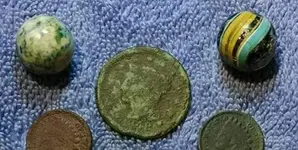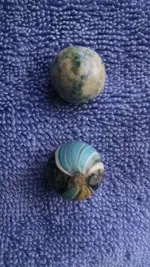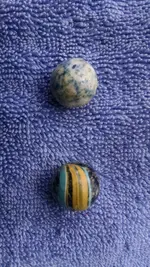I think this is what your colored one is called - Nice finds!!!!
INDIAN SWIRLS
Indian Swirls typically possess an opaque black base. However, some are translucent (so-called Maglites, since a powerful flashlight is required to make light pass through them), and these will have an amethyst, dark green, red, amber, or blue base. On the surface will be stretched bands of color; some go from pontil to pontil while others are discontinuous and are often referred to as "end of day." A variety of colors may occur; yellow and white are most common, followed by red, blue, green, orange, and lavender. Oxblood is found only extremely rarely.
The colored bands commonly occur in panels. There are usually two panels, though individual panels are frequently found, while three-paneled examples are more scarce. At other times the bands will be more or less random and on occasion cover nearly all of the marble's surface. These latter examples are called 360 degree Indian Swirls and are highly prized.
On some Paneled Indians there will be a set of white or colored strands under the surface. The panels are usually edged with white or yellow strands on the surface. These are sometimes known as Submarine Indians.
Banded Indian Swirls are similar to Paneled Indian Swirls, except that they exhibit multiple single colored bands that are typically edged on both sides by another color, usually white.








